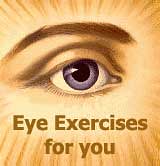
A friend of mine, who is a glaucoma suspect, has come up with a routine of eye exercises that reliably reduce his intraocular pressure. He visited my office a few months ago and demonstrated his eye exercises for me. We measured his intraocular pressure with a sophisticated tonometer (the Reichert Ocular Response Analyzer) immediately before and immediately after his eye exercises. I confirmed that just a few minutes of the exercises can indeed reduce his IOP significantly. He measures his own results from these eye exercises with a Reichert AT555 tonometer.
These eye exercises are a variation on the Bates Method of natural vision improvement. We would like to share the exercises with everyone and ask all of those people participating in the FitEyes.com self-tonometry research to try these exercises and report the results. The exercises require just five minutes.
Read the full instructions below. At your choice, perform either option A or option B and combine it with the blinking technique described below.
A. Alternate between looking on very distant and very close objects. For example, when walking on the street or looking at the window, I alternate between looking on my nose and looking on some far building or mountain. The glasses are always off. The eyes are never fixed on any object, and they are moving all the time.
B. Alternate between looking right and left. As before, the glasses are off and the eyes are moving all the time.
Blinking. Very light and fast blinking, the eyelids are light as "butterfly wings".
Combine either A or B with the blinking and perform them simultaneously.
My friend say, "Usually, 5 minutes of such exercises are enough for me to see a reduction of the IOP by 2 to 5 points." Again, I can confirm these results according to test we conducted at my office.
We would like everyone participating in the FitEyes.com self-tonometry research project to try this and record the results several times - the more times you test it the better. Try it at different times of the day and under different conditions.
I suggest that it is important to do the exercises without strain or effort. Just take it easy and do them effortlessly. To help with the research, please note any changes in mental state or emotions. In particular, note whether you your state of relaxation (or stress) changed over the course of the 5 minutes of performing the eye exercises. It would be ideal for this test if there is no change in your mental state, but if you feel there is, simply report the change.
Because there are many potential biases in this test, it would help if we have lots of repetitions of the test. The more, the better. My friend has continued to have success over the course of several months with these eye exercises lowering his IOP.
Filed Under (tags):
- dave's blog
- Log in or register to post comments

